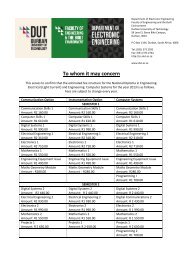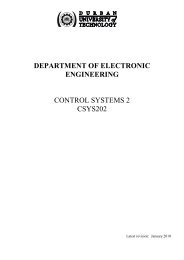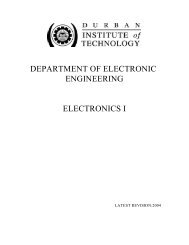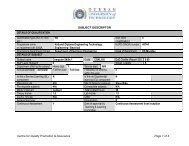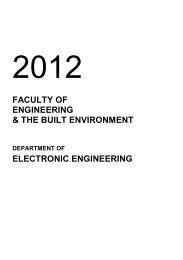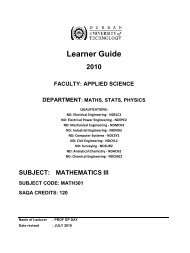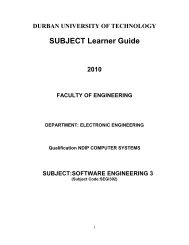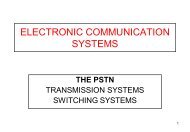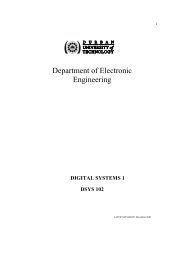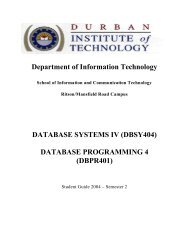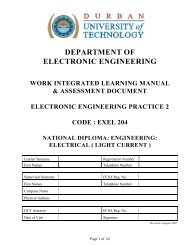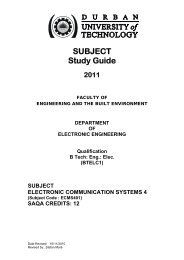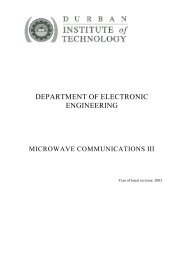Programming 2 - CS DUT
Programming 2 - CS DUT
Programming 2 - CS DUT
You also want an ePaper? Increase the reach of your titles
YUMPU automatically turns print PDFs into web optimized ePapers that Google loves.
INSTABILIDADE ANTERIOR DO OMBRO ASSOCIADA COM GRANDE LESÃO DE HILL-SACHS: TRANSFERÊNCIA DO TENDÃO DO INFRA-ESPINHOSOFig. 5 – Fotografia intra-operatória que mostra o grande defeito de Hill-Sachs do ombro esquerdoFig. 6 – Desenho esquemático: a transferência do tendão do infra-espinhosopara dentro do defeito de Hill-Sachs.TABELA 1Descrição dos sete pacientes, com diagnóstico de luxação recidivantedo ombro com grandes lesões de Hill-Sachs, no período 1990-1995Paciente Idade Sexo Lado 1ª luxação Diagnóstico Cirurgia(Convulsão)ARC 53 F D Sim Epilepsia ArtroplastiaJLRR 47 M D Sim Epilepsia Bristow (recidiva)MGASC 29 F D Sim Eclâmpsia P. Platt (recidiva)Transf. IEE Sim Eclâmpsia ConservadorNL 48 M E Sim Alcoolismo Transf. IESPS 41 M D Sim Alcoolismo –SSM 22 M D Sim Indefinido Transf. IEE Sim Indefinido P. Platt (recidiva)WSM 29 M D Sim Epilepsia Transf. IEP. Platt = Cirurgia de Putti-Platt; Transf. IE = Transferência do tendão do infra-espinhoso; Bristow = Cirurgia de Bristow.tendinosa, leva à estabilização articular, com baixa morbidade.MATERIAL E MÉTODOSNo período de 1990 a 1995, foram estudados nove ombrosde sete pacientes com instabilidade anterior do ombro comgrandes lesões de Hill-Sachs (tabela 1). Dois eram do sexofeminino e cinco do masculino. A idade variou de 22 a 53anos, com média de 38,4 anos. Seis ombros foram acometidosdo lado direito e três do esquerdo. A primeira luxaçãoem todos os casos foi relacionada com convulsões, três acompanhadosde queda, dois inconclusivos e quatro sem nenhumarelação com queda durante as crises convulsivas (confirmadopelos familiares). Já as recidivas das instabilidades ocorreramcom maior freqüência à noite, durante o sono ou quandoarremessavam algum objeto com o ombro pouco abduzido emais raramente durante as convulsões.Uma paciente com eclâmpsia apresentou luxação bilateralglenumeral com grandes lesões de Hill-Sachs durante criseconvulsiva sem nenhuma queda. Apenas o ombro direito fi-Rev Bras Ortop _ Vol. 31, Nº 9 – Setembro, 1996 715
d) Library orientationCompleted in Department Orientation.5. Copyright and plagiarismPlagiarism is the use of any work, writings or ideas belonging to someoneelse and presenting it as your own. No form of plagiarism will be acceptedand disciplinary action will be taken against any learner perpetrating thiscrime.6. Student supportThe Student Counselling centre is situated in the basement of the CecilRenaud Theatre on Steve Biko Campus. They assist with study skillprogrammes,Please make use of the consultation times with the lecturer to improve youracademic performance.Additional tutorial lessons will be conducted to assist students who areexperiencing major difficulties in coping with the subject.Spot tests will be conducted on a regular basis to assess learner’sperformance.7. Work Integrated Learning (WIL), industry, community, and occupationrelatedinformation.The group project aims to integrate the hardware and software by mergingthe outcomes of subjects like Electronics 1 and <strong>Programming</strong> 1.8. Quality assurance and enhancementPRE001 and PRE002 evaluations will be conducted during the semester toobtain feedback from students. It is important that you provide honestfeedback, as this will enable the lecturer to make positive changes toenhance the teaching and learning process.Template updated: September2009 by the CQPA and CELTPage 5 of 10
Learning outcomes Assessment criteria Assessment methods• Dynamically createand release memory.• Read from and writeto secondary storagemedia.• Create abstract datatypes.• Operatoroverloading.• Single inheritance.• Communicating withhardware attached tothe parallel port.• Design a programthat creates andreleases memorydynamically.• Design anapplication thatreads from andwrites to asecondary storagemedia.• Create anapplication that usesabstract data types.• Design anapplication that reusesand redefinesmethods.• Create anapplication thatderives classes fromexisting classes.• An application thatcommunicates withthe parallel port.Weekly tutorials.Assignment 1 – 25/02Weekly tutorials.Test 1 – 10/03Weekly tutorials.Assignment 2 – 15/03Weekly tutorialsWeekly tutorialsPractical Test-28/04Group Project- 7/05Page 6 of 10
Scheme of work:WK TOPIC COMPLETED1 1. Pointers1.1. Pointer variable declarations and initialisation1.2. Pointer operators1.3. New and Delete1.4. Pointers with character2 2. String Class2.1. String Manipulation2.2. Functions (Converting to char etc.)3 3. File Processing3.1. Create, read, write and update files3.2. Sequential File processing3.3. Random Access file processing4 4. OOP4.1. Create classes – constructor, destructor4.2. Set and get methods4.3. Overloading constructors5. 5. OOP5.1. Composition5.2. Array of Objects6. 6. OOP6.1. Single Inheritance7. 7.Bits, Characters, Strings and Structures7.1. Structure Definitions7.2. typedef7.3. Bitwise operators7.4. Bit Fields8. 8. The Preprocessor8.1. Using #include8.2. Using #define9. 9. Standard Template Library (STL)9.1. Using STL containers9.2. Using Iterators to access the elements of STLcontainers10. 10. Graphics in C++11 11. Interfacing with the PC Parallel Port11.1 Writing to the parallel-port11.2 Reading from the parallel portRelevant readings/referencesBooks on C++ or G++ Introduction to programmingWebsiteshttp://www.programmersheaven.comhttp://www.codeproject.comor a Google search on programming in C++Dates for submission of assignmentsAssignment 1 25 FebruaryAssignment 2 8 AprilGroup Project 30 AprilAssignment return/feedback datesPage 7 of 105 March15 April4 May
ASSIGNMENT 1DUE DATE: 25 FebruaryThe introduction of computers/technology is believed to make manual timeconsumingtasks much simpler, better and faster.This assignment requires you to integrate your Computer Systems knowledge with<strong>Programming</strong> 2. You are required to identify a problem in one of your other subjectsand design a suitable computer solution in g++. Your solution must be well-designedand well-documented.Example: You can design a program that can be used to solve a mathematicalproblem where the whole number and fraction need to be separated and appliedseparately to a formula. Your program will have to input a real value as a string andsplit the two parts using string manipulation functions.The problem statement (must be relevant to a subject) and your details must beincluded as comments at the beginning of your program.Your software solution must use pointers, strings and characters.Proposed Mark Allocation: (Subject to Change)Problem Statement (clearly worded problem from one of your other courses) 5Menu Design (User-friendly, user must decide when to exit) 5Problem Processing (Calculations etc.) 10Appropriate use of Functions 5Appropriate use of Pointers, Strings and characters 5Validate input 5Program design, Documentation 5Total 40ASSIGNMENT 2DUE DATE: 8 AprilThe introduction of computers/technology is believed to make manual timeconsumingtasks much simpler, better and faster.This assignment requires you to integrate your Computer Systems knowledge with<strong>Programming</strong> 2. You are required to identify a problem in one of your other subjectsand design a suitable computer solution in g++. Your solution must be well-designedand well-documented. You must use Classes and Files.The problem statement (must be relevant to a subject) and your details must beincluded as comments at the beginning of your program.Proposed Mark Allocation (Subject to Change)Problem Statement (clearly worded problem from one of your other courses) 5Menu (User-friendly, user must decide when to exit) 5Class Definition (problem area/processing) 18Creating, Updating Files 12Driver Program 10Program efficiency, documentation 5Total 55Page 8 of 10
GROUP PROJECTHardware and SoftwareDUE DATE: 30 AprilYou are required, as part of a group (Min. 5 & Max. 6), to develop a softwareapplication that interfaces with hardware through the parallel port, serial port or USB.This software program must also be professionally presented. Each group mustdocument the process of software development from the proposal (conception of theidea) to the implementation of the software program. You will be required to use the6 th Habit – Synergize from the 7 Habits of highly effective people, extensively. Cooperatewith each other using your knowledge and skills from each other as well asfrom your other subjects (Digital Comms, Networks, Electronics etc.)A maximum of 80% will be allocated for all work produced that incorporates theconcepts covered and specified belowThe remaining 20% is awarded for incorporating any additional softwaredevelopment functionalities that your group has researched and is not covered in thesyllabus.Compulsory – 80%Choose an application area of your choice and design a program to input, processand output information.Requirements include use of all topics in the syllabus (See Proposed Scheme ofWork on page 7)Optional – 20%Use of additional structures, functions, libraries etc.SUBMISSION OF PROJECTAll projects must be submitted professionally like off the shelf packages in a box withthe following:• Printed copy of User Manual and Programmers/Developers ManualFailure to submit the project professionally will result in your group losing 5% of theoverall mark.PROPOSED MARK ALLOCATION (Subject to Change)Topic / ConceptMarks1. Idea, Project Proposal 102. Start Up Login and Password Control (Exit after 3 tries etc.) 103. User Interface Design 104. Data Validation. User Friendliness. 105. User and Developer Manual 106. Online Help within the program 107. Hardware, Networks 108 Additional (Any other topic that was not covered in the syllabus) 20Each additional concept contributes 5 marks. Group qualifies for 20 ifthey have implemented 4 additional topics.9. Program Design (OOP) 10Page 9 of 10
Page 10 of 10



